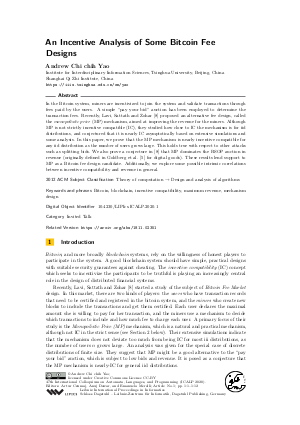An Incentive Analysis of Some Bitcoin Fee Designs (Invited Talk)
Author Andrew Chi chih Yao
-
Part of:
Volume:
47th International Colloquium on Automata, Languages, and Programming (ICALP 2020)
Part of: Series: Leibniz International Proceedings in Informatics (LIPIcs)
Part of: Conference: International Colloquium on Automata, Languages, and Programming (ICALP) - License:
 Creative Commons Attribution 3.0 Unported license
Creative Commons Attribution 3.0 Unported license
- Publication Date: 2020-06-29
File

PDF
LIPIcs.ICALP.2020.1.pdf
- Filesize: 448 kB
- 12 pages
Document Identifiers
Related Versions
Subject Classification
ACM Subject Classification
- Theory of computation → Design and analysis of algorithms
Keywords
- Bitcoin
- blockchain
- incentive compatibility
- maximum revenue
- mechanism design
Metrics
- Access Statistics
-
Total Accesses (updated on a weekly basis)
0Document
0Metadata
Abstract
In the Bitcoin system, miners are incentivized to join the system and validate transactions through fees paid by the users. A simple "pay your bid" auction has been employed to determine the transaction fees. Recently, Lavi, Sattath and Zohar [Lavi et al., 2019] proposed an alternative fee design, called the monopolistic price (MP) mechanism, aimed at improving the revenue for the miners. Although MP is not strictly incentive compatible (IC), they studied how close to IC the mechanism is for iid distributions, and conjectured that it is nearly IC asymptotically based on extensive simulations and some analysis. In this paper, we prove that the MP mechanism is nearly incentive compatible for any iid distribution as the number of users grows large. This holds true with respect to other attacks such as splitting bids. We also prove a conjecture in [Lavi et al., 2019] that MP dominates the RSOP auction in revenue (originally defined in [Goldberg et al., 2006] for digital goods). These results lend support to MP as a Bitcoin fee design candidate. Additionally, we explore some possible intrinsic correlations between incentive compatibility and revenue in general.
Cite As Get BibTex
Andrew Chi chih Yao. An Incentive Analysis of Some Bitcoin Fee Designs (Invited Talk). In 47th International Colloquium on Automata, Languages, and Programming (ICALP 2020). Leibniz International Proceedings in Informatics (LIPIcs), Volume 168, pp. 1:1-1:12, Schloss Dagstuhl – Leibniz-Zentrum für Informatik (2020)
https://doi.org/10.4230/LIPIcs.ICALP.2020.1
BibTex
@InProceedings{yao:LIPIcs.ICALP.2020.1,
author = {Yao, Andrew Chi chih},
title = {{An Incentive Analysis of Some Bitcoin Fee Designs}},
booktitle = {47th International Colloquium on Automata, Languages, and Programming (ICALP 2020)},
pages = {1:1--1:12},
series = {Leibniz International Proceedings in Informatics (LIPIcs)},
ISBN = {978-3-95977-138-2},
ISSN = {1868-8969},
year = {2020},
volume = {168},
editor = {Czumaj, Artur and Dawar, Anuj and Merelli, Emanuela},
publisher = {Schloss Dagstuhl -- Leibniz-Zentrum f{\"u}r Informatik},
address = {Dagstuhl, Germany},
URL = {https://drops.dagstuhl.de/entities/document/10.4230/LIPIcs.ICALP.2020.1},
URN = {urn:nbn:de:0030-drops-124087},
doi = {10.4230/LIPIcs.ICALP.2020.1},
annote = {Keywords: Bitcoin, blockchain, incentive compatibility, maximum revenue, mechanism design}
}
Author Details
References
-
Moshe Babaioff, Shahar Dobzinski, Sigal Oren, and Aviv Zohar. On bitcoin and red balloons. In Proceedings of the 13th ACM Conference on Electronic Commerce, pages 56-73, New York, NY, USA, 2012. Association for Computing Machinery.

-
Joseph Bonneau, Edward W Felten, Steven Goldfeder, Joshua A Kroll, and Arvind Narayanan. Why buy when you can rent? bribery attacks on bitcoin consensus, 2016.

-
Miles Carlsten, Harry Kalodner, S Matthew Weinberg, and Arvind Narayanan. On the instability of bitcoin without the block reward. In Proceedings of the 2016 ACM SIGSAC Conference on Computer and Communications Security, pages 154-167, 2016.

-
Andrew V Goldberg and Jason D Hartline. Competitive auctions for multiple digital goods. In European Symposium on Algorithms, pages 416-427. Springer, 2001.

-
Andrew V Goldberg, Jason D Hartline, Anna R Karlin, Michael Saks, and Andrew Wright. Competitive auctions. Games and Economic Behavior, 55(2):242-269, 2006.

-
G Huberman, J Leshno, and CC Moallemi. Monopoly without a monopolist: An economic analysis of the bitcoin payment system. ssrn scholarly paper id 3025604. Social Science Research Network, Rochester, NY, 3054887, 2017.

-
Joshua A Kroll, Ian C Davey, and Edward W Felten. The economics of bitcoin mining, or bitcoin in the presence of adversaries. In Proceedings of WEIS, volume 2013, page 11, 2013.

-
Ron Lavi, Or Sattath, and Aviv Zohar. Redesigning bitcoin’s fee market. In The World Wide Web Conference, pages 2950-2956, 2019.

